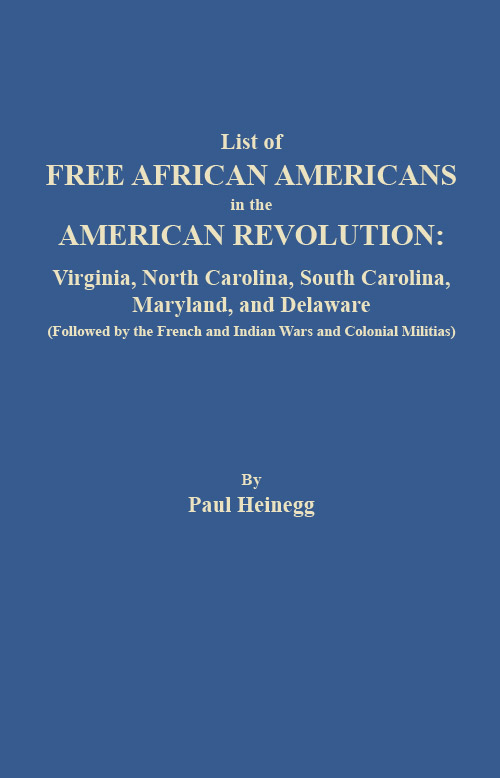
We were pleased to receive positive feedback on three of our most popular titles of the second half of 2021: DNA for Native American Genealogy, by Roberta Estes; Scottish Genealogy: The Basics and Beyond, by Dr. David Dobson; and List of Free African Americans in the American Revolution, by Paul Heinegg. We are happy to share them with our readers below.
DNA for Native American Genealogy, by Roberta Estes
“Roberta Estes is one of my favorite bloggers, so I was excited to receive a copy of her new book to review.
Many Americans claim Native American heritage in the family tree, but their beliefs are based on family lore, not documentary evidence.
Roberta Estes is well known in the genealogy world for her DNA expertise, which she shares on DNAeXplained – Genetic Genealogy.
As with her blog, Roberta has a detailed book covering everything one needs to know about documenting Native American heritage through DNA analysis.
The book is divided into 6 parts:
Introduction
Part 1: Seeking Native Ancestors
Part 2: Ethnicity and Population Genetics
Part 3: DNA Testing Vendors and Autosomal Tools
Part 4: Mitochondrial DNA – Ancient and Modern
Part 5: Y DNA – Ancient and Modern
Part 6: Your Roadmap and Checklist
Glossary
The most common question, I think, from someone who wants to prove Native American ancestry is “Can I join a tribe?” Roberta’s answer is perfect – the short answer is NO and the longer answer is that it’s complicated and it takes a thorough reading of the book to understand the whys.
Part 1 goes in depth identifying who the Indigenous People of the Americas are, what DNA results can and can’t tell the tester and background history of tribes and Native American life and how it connects to today’s world and how family stories fit into the research picture. Part 1 is extremely important in understanding the overall DNA picture as it relates to possible Native American ancestry.
Part 2’s subtitle Ethnicity, Biogeographic Ancestry, Populations and Communities best explains what it is about and is the first step into understanding DNA results, based on ethnic groups and geography.
Part 3 introduces the main companies involved in DNA testing – FamilyTreeDNA, MyHeritage, Ancestry, 23andMe and their products. Getting into specifics can be confusing, particularly for a beginner in the DNA process. However, there are multiple images accompanying the explanations about how each company reports and groups results and the testing tools that they offer.
Parts 4 & 5 provide an in-depth explanation of DNA in mankind through both mitochondrial (maternal) DNA and paternal Y-DNA and the haplogroups that indicate indigenous ancestry. Parts 4 & 5 are key to identifying Native American roots.
Part 6 is a checklist of steps to take before making the decision to jump into DNA testing. Roberta also suggests further steps to take after DNA test results are received.
The 9-page Glossary includes specialized terms with which the reader might not be familiar and is a helpful addition to the book.
Having read Roberta’s blog for years, I can vouch that she is a careful, methodical and thorough researcher who presents information in an easy-to-follow format.
DNA for Native American Genealogy is written in the same familiar style, so even though she provides a great deal of information in 165 pages, beginners will understand the process and more advanced researchers will also benefit.
I highly recommend this book for anyone who seriously wants to pursue documenting Native American heritage in the Americas.- Linda Stufflebean, Empty Branches on the Family Tree, 01/01/2022.” View Book Details
Scottish Genealogy: The Basics and Beyond, by Dr. David Dobson
“ . . . The book goes on to discuss major record sources, both civil and church. It then offers the reader secondary sources, many of which are unique to Scotland. Most entries provide examples and a link to the repository. Of special interest are the many records related to a person’s occupation, whether they were a mariner, a fisherman, or a merchant. The book ends with a chapter on emigration and migration patterns.
This book is not a step-by-step guide to doing genealogical research, but rather provides a comprehensive source of record sets and repositories. It deserves a place on the shelf of anyone with Scottish ancestors.”—Nancy Remington, The Bulletin [of the Genealogical Forum of Oregon], December 2021.
“. . . . As a Scottish Genealogist I was delighted to be asked to review this book!
I was not disappointed! This is an amazing book suitable for not only the Beginner to Scottish Genealogy
Research but for those who have been researching for a while & want to advance their research to the next level.
Chapter I is for the beginner & provides detail on how to access Statutory Birth, Marriage & Death records as well as Old Parish Records online. There is a section on Scottish surnames & the origins of these…something in my opinion most beginners should take the time to understand. The remainder of the chapter lists out Scottish National & Local Archives & Libraries as well as some useful websites to assist your research.
Chapter 2 lists out major record sources & goes into Birth, Marriage & Death Records & Old Parish Records in more detail & gives examples of what you might find within these records.
Chapter 3 focuses on Church & Religious Records & gives background on each of the Churches with details of publications & websites that can be consulted for each.
In Chapter 4 the Author lists out Secondary Sources that can be consulted, these include Monumental Inscriptions, Statistical Accounts, Heritor Records, Tax & Land Records & Court Records. There is also an amazing amount of information provided in relation to Maritime Records. The end of this chapter concentrates on Craftsmen, Merchants, Militia, Regiments, Schools, Prison, Jacobites, Poor Law & Health Records.
Chapter 5 concentrates on Emigration. I know from client research that this is something that many overseas researchers struggle with, they perhaps know that their Ancestors came from Scotland but are unable to find records of their passage or detail of where in Scotland they originated. This chapter does not disappoint & provides historical background on when/why the Scots Emigrated to certain areas. It includes sections on a lot of the Countries in Europe as well as Australasia, America, Africa, Asia & The West Indies.
I really enjoyed this book; it is straight to the point without bogging the reader down with too much detail. There are some amazing examples & lots of hints & tips on where to check for further information including publications & websites.—Clare Wilson, Treehouse Genealogy, June 28, 2021.” View Book Details
List of Free African Americans in the American Revolution, by Paul Heinegg
“Paul Heinegg is a prolific researcher and compiler of African American records, which are invaluable to family historians.
His latest book has a very long title, which fully details the amazing amount of biographical information contained within:
List of Free African Americans in the American Revolution: Virginia, North Carolina, South Carolina, Maryland, and Delaware (Followed by the French and Indian Wars and Colonial Militias)
Lacking a pension, it is often difficult to prove Revolutionary War service for anyone, especially if there were two or more men of the same name living in a neighborhood. Proving war service of African Americans is even more difficult.
Mr. Heinegg has compiled 160 pages of biographical data covering five states and has extended his research to reach back to earlier colonial times . . . .
Biographical entries are in alphabetical order by location. Here are examples of the kind of details to be found:
James McKoy – free mulatto farmer in Westmoreland County, Virginia in 1801. Applied for a pension for war services of 15 months, including Yorktown. Stated he was born in St. Mary’s County, Maryland and that he moved to Virginia with his father when he was about 8 years old, etc.
Talbot/Talbert Thompson – purchased his freedom after his master, Alexander McKensie, moved to England. Petitioned Virginia for his freedom in 1761. Many details about the purchase of his wife, Jenny, from her master. He also owned a slave, himself, named Joseph. Loyalist during the Revolution and died in April 1782 in New York just before his family left for Canada, etc.
Samuel Hansor, aged 24, listed in muster of Captain John Wright’s Delaware Company in the French and Indian War on 11 May 1759. Married Comfort Hanzer before 15 April 1770 when daughter Ann was baptized at St. George’s Chapel, Indian river Hundred, Delaware.
Who wouldn’t love to find an ancestor or two in such a well documented book?
As with earlier works, Paul Heinegg has assembled a book of fascinating and invaluable details about the lives of African Americans in early American history.
For anyone doing early African American research, this is an excellent book to have on the reference shelf of your home library.—Linda Stufflebean, Empty Branches on the Family Tree, 01/09/2022.”
“ . . . Heinegg is noted for his research on free African Americans. The very detailed and documented biographical sketches in this publication are arranged alphabetically by state, with a full name index at the end of the book. Besides the Revolution, he includes people connected to the earlier French and Indian Wars, and some Native Americans. This is the first of its kind that I know about and is a landmark work. It took years to compile the research . . .”—Ken Thomas, “Genealogy,” Atlanta Journal -Constitution, 01/07/2022. View Book Details






